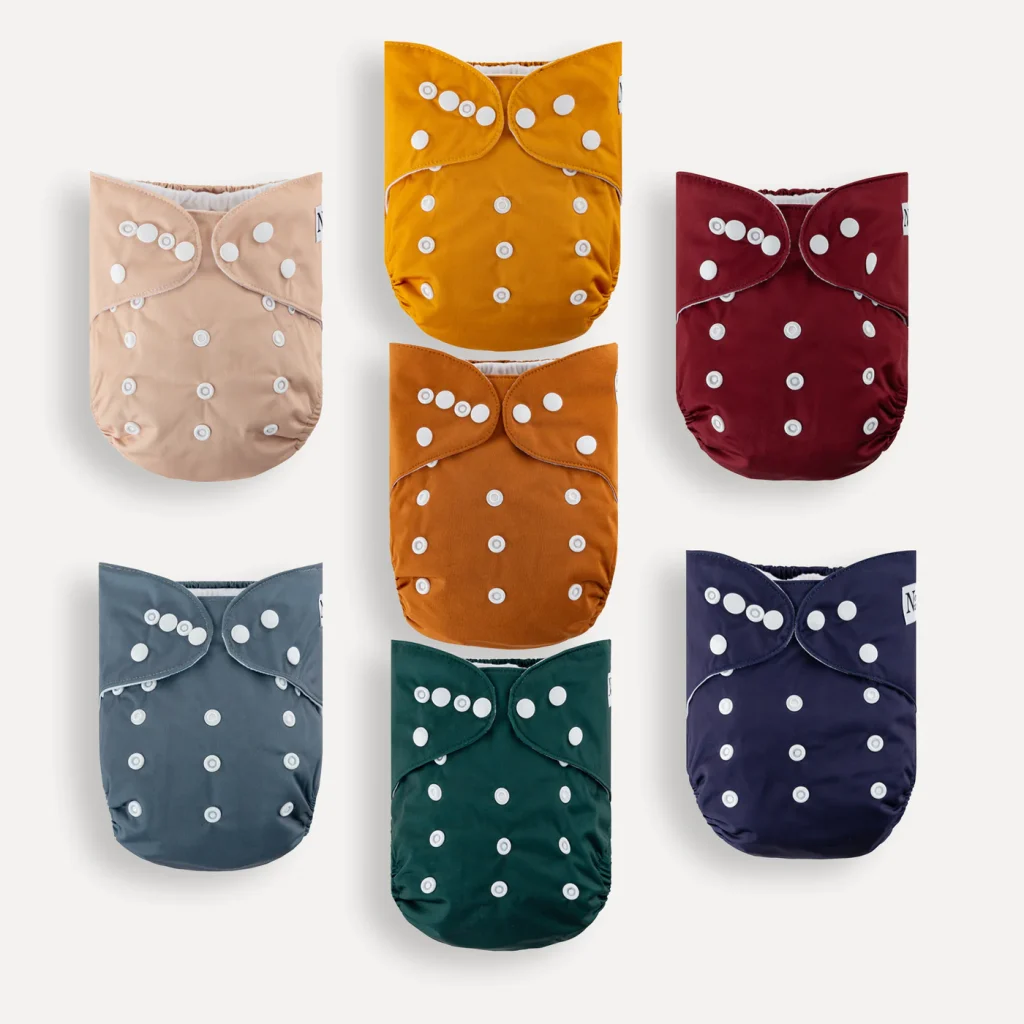Cloth diapers, yay or nay?
It’s been nearly 8 months that I’ve been exclusively using cloth diapers for my baby girl. It was overwhelming in the beginning but as soon as I started using it, I got really into it. It’s easy, clean, and I feel better knowing that she’s wearing natural fiber diapers. I started with one kind but now I have several styles of covers and inserts. Now I have strategies around it. Are you curious about how to use clothe diapers? Do you think it’ll be the right fit for you? Read on.
Why do I like cloth diapers?

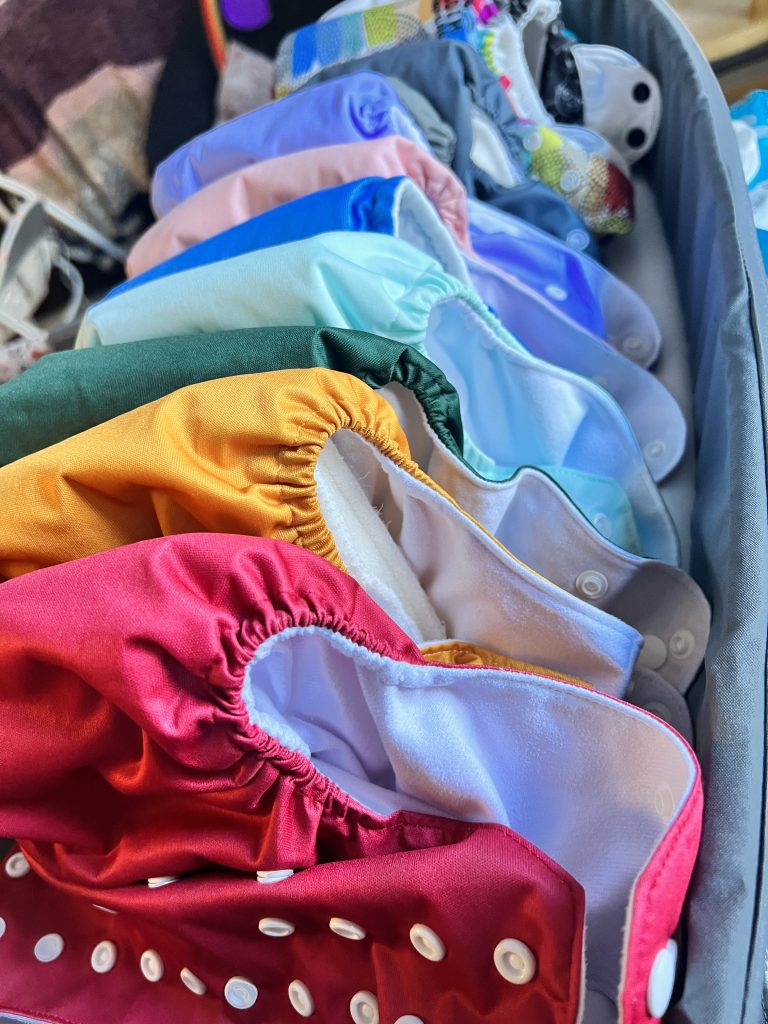
Ever since I learned about cloth diapers more than 10 years ago, I made up my mind to use it when I have my own baby. And here she is. I didn’t start right from the beginning though. A first time mom. Breastfeeding. Recovering from the birth. I had too much going on to figure out something totally new. But in about a month the cloth diapering because our routine. There are many reasons why I love using cloth diapers and here are my top reasons.
I like using natural fabric to the most sensitive part of my baby’s skin. I am very particular about fabrics, I exclusively use cotton, bamboo, hemp, or soft wool for all baby’s clothing. Not all cotton fabric is made the same, so I tend to use higher quality ones. We Koreans are very particular about the quality of cotton. All the inserts of the diapers I use are made with organic cotton, bamboo, or hemp.
During the first few days of my baby’s life, we got used to the pee smell. Those disposable diapers now have yellow line that turns into blue when it gets wet, but you can also tell by the smell. I thought that was the smell of baby’s urine. Then, we went through a bag of disposable diapers and started a different bag of the same brand. Suddenly I smelled something totally new and it freaked me out. As a new mom, I thought of all the horrible scenarios. Is she sick? Does she have UTI? Did I not clean her enough? I constantly smelled her diapers for days to see if there’s any differences. Later I found out it was because the diapers were from a different batch and the smell that we got used to as the “baby pee” was actually the smell of diapers. If you smell your baby’s pee alone, it actually doesn’t have a lot of odor, which makes sense. Ever since, I switched to cloth diapers and never looked back.
It’s also cost-effective in the long run. The diaper covers can be pricy, especially if you want the prettiest designs, and there are oh so many! But you don’t have to worry about how many diapers you go through in a day and buy a stack of diapers. You can even use the diapers for multiple babies.

I like that diapers don’t go into the landfill. Most of the disposable diapers in the market are made with plastic. When I was using them in the first month, I couldn’t look over the fact that we were throwing out one full trash bag of diapers each week. Here’s another diaper related story: Many years ago, I was in Alaska’s Arctic in winter. You might remember the trip since I constantly talk about it. We crossed the Atigun Pass, the highest pass in Alaska at 4,739 feet. We approached the vast Arctic desert, I was in awe looking at the scenery. Then I saw a lump on the side of the road, thinking it was an odd shape to be in this area. Can you guess what it was? A frozen ball of diaper. I couldn’t believe my eyes. A disposable diaper reached this far up north. It would’ve been buried under snow and ice, perhaps our next generation would discover it like archeological artifacts. The picture above is exactly where I saw the diaper, right in the middle of the Arctic desert.
What are cloth diapers?
Cloth diapers are a popular and eco-friendly alternative to disposable diapers. They work by providing a reusable, washable cloth barrier between your baby’s skin and their waste. That’s what everyone used before there were disposable diapers around. Back then, it was a big piece of cloth, folded and pinned to stay on the baby. Remember those big safety pins? But now it looks a bit different.
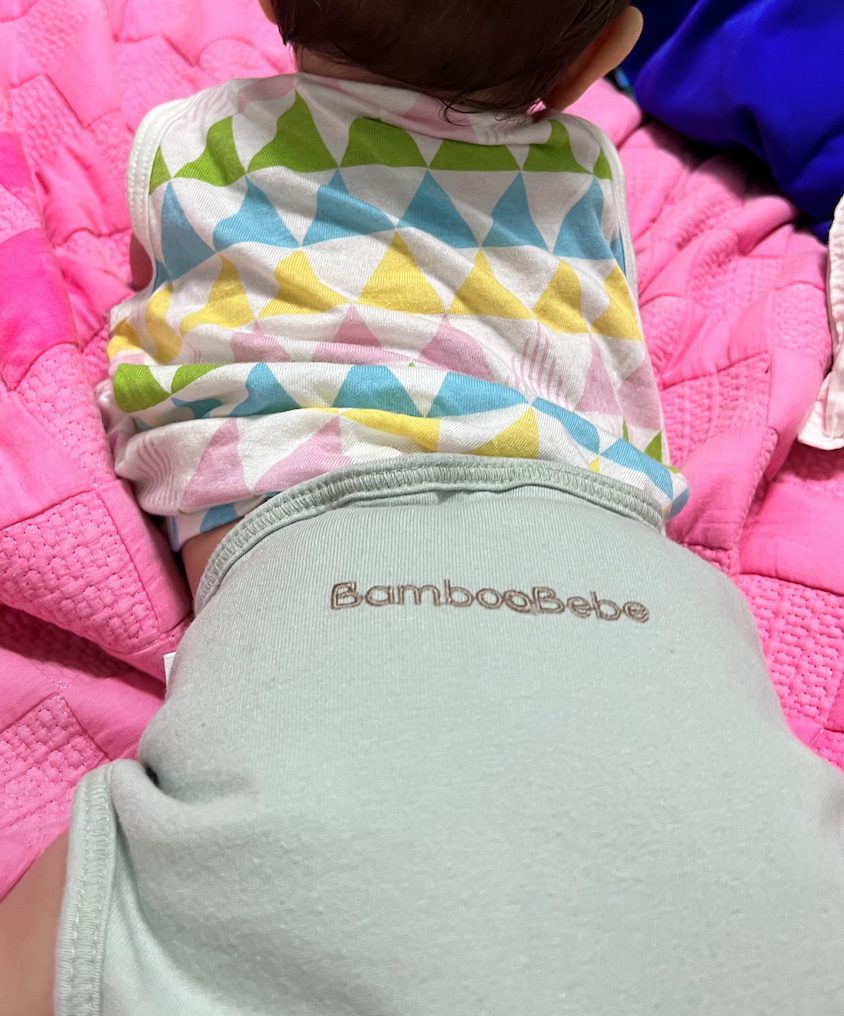
What do I need for cloth diapering?
- Cloth diapers, both covers and inserts. I listed my favorite brands per each kind in this post.
- Waterproof laundry collection bag (pail liner): you can use it as a trash can lining. I use these and working out great.
- If you are exclusively using cloth diapers, have it minimum of 15-20 so you don’t have to wash everyday. A baby goes through 6-10 diapers each day.
- A dedicated trash can: since the diapers will sit in the bag for a day or two, you want to use a trashcan with a lid. It doesn’t need a special diaper pail, just any trash can with a lid would work.
- Waterproof bag or pod for your diaper bag
- Baby-friendly laundry detergent
How does a cloth diaper work?
If you haven’t seen how it works, it can be a difficult concept to understand. Most cloth diapers consist of two parts: an absorbent inner layer and a waterproof outer layer. The inner layer is usually made of cotton or bamboo, which are highly absorbent and soft against your baby’s skin. The outer layer, often made of waterproof material, is designed to keep moisture and messes contained.
What happens when a baby pees or poos?
Baby wears the diaper just as a disposable diaper. It looks just like it. When baby pees, you can take it off, take the insert out (if the insert goes in the pocket, which we will discuss later), and put all in the laundry basket. Easy. What scares parents away the most is when they try to imagine what happens when the baby poos on the cloth diaper. But, it’s just as simple.
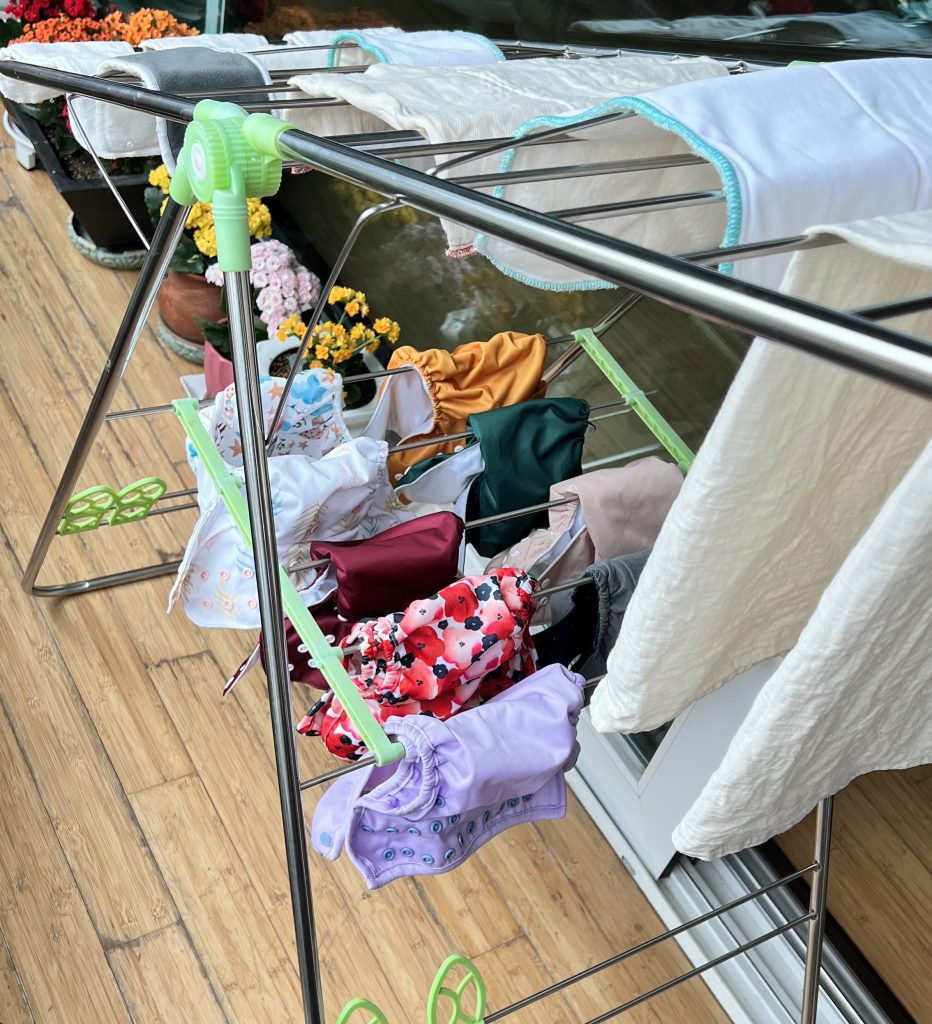
Before your baby starts solid, their poo will be watery. It’ll be like runny and brown, sort of sticky liquid. If your baby is breastfed, it tends to be watery. In this stage, baby’s poo is water soluble. No need to worry about leaving a chunk in your washing machine. Simply take the diaper off, and put all the pieces in the laundry basket. If you think there’s too much on the diaper, you can try to dump some in the toilet before putting it in the laundry.
After your baby starts solid, the game changes. Your baby will poo like just grownups do. But don’t fear. This time you will have to dump the solid in the toilet before putting in the washing machine. Use the spray or shower head to knock solids in the toilet. Sometimes I wash the insert in the toilet bowl. Depending on what they eat the poo might be runny or more solid. Thankfully my baby poos in a more solid form which make it easier to clean. After that, the cover and insert both go into the washing machine.
How cloth diapers work
Now we know the basics of cloth diapers, let’s talk details.
There are different kinds of diapers and strategies around it but there are three big methods.
Pocket diapers
It’s the easiest and the most common way to use the cloth diapers. The diaper cover is made with waterproof material on the outside and there’s a lining inside which creates a pocket. An insert, usually a pre-made (looks like a sanitary pad) goes inside. Once the diaper is soiled, you will have to take the insert out before put all in the wash bin.
Pros
It’s easy and simple. Works just like a disposable diaper.
Cons
Depending on what brand you get, the lining fabric isn’t the nicest. I’ve used four different pocket diaper brands and I’m not a fan of any of the lining fabric except one. It creates too much lint, which means some of them end up in my baby’s butt.
My method
My solution is to put the liner outside of the pocket lining, so using the pocket diaper as a cover. Since I have high quality liners, this has been working well for me.
Diaper covers
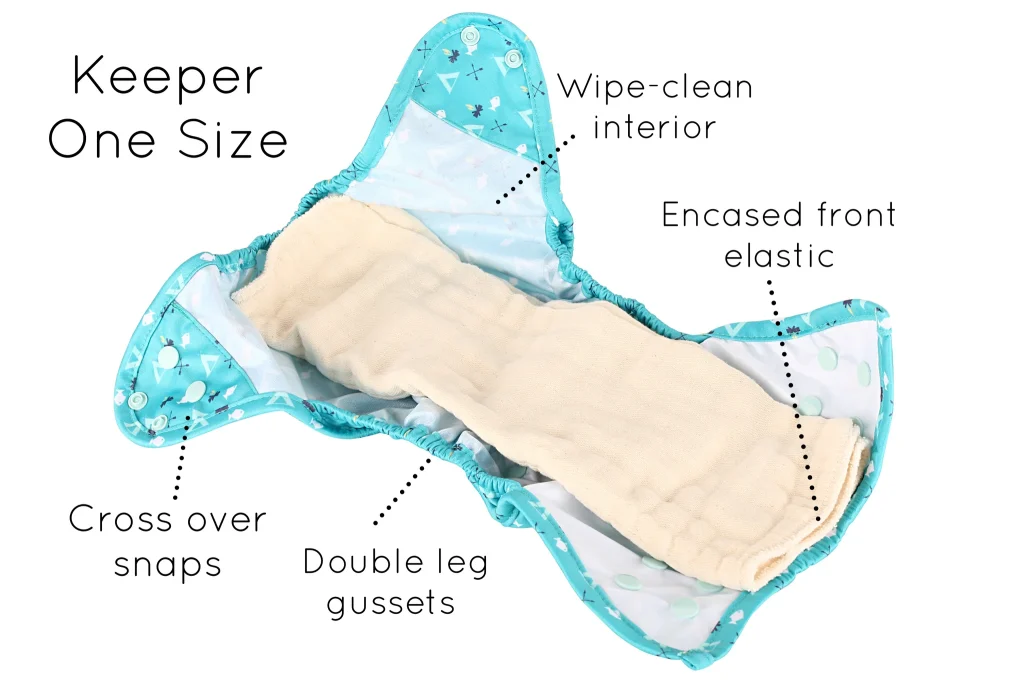
Petite Crown diaper cover “Keeper”
Think the pocket diaper covers without the lining. It’s a shell that goes over any inserts.
Pros
It takes no time to dry. Sometimes you don’t even have to wash it. Just wipe it off!
Cons
You have to use the right kind of inserts since there’s no pocket or lining to hold them in one place.
My method
I like using flat or pre-fold inserts for this. Premade pads easily move around in this.
All-in-one

LPO Boutique all-in-one diaper
This is the cover and insert all together. The insert is sewn in, so you don’t have to worry about looking for two different pieces.
Pros
Easy! Everything is in one place.
One insert is sewn in, so it’s easy to double up the lining for absorbency.
Cons
It takes longer to dry.
Inserts
Pre-made
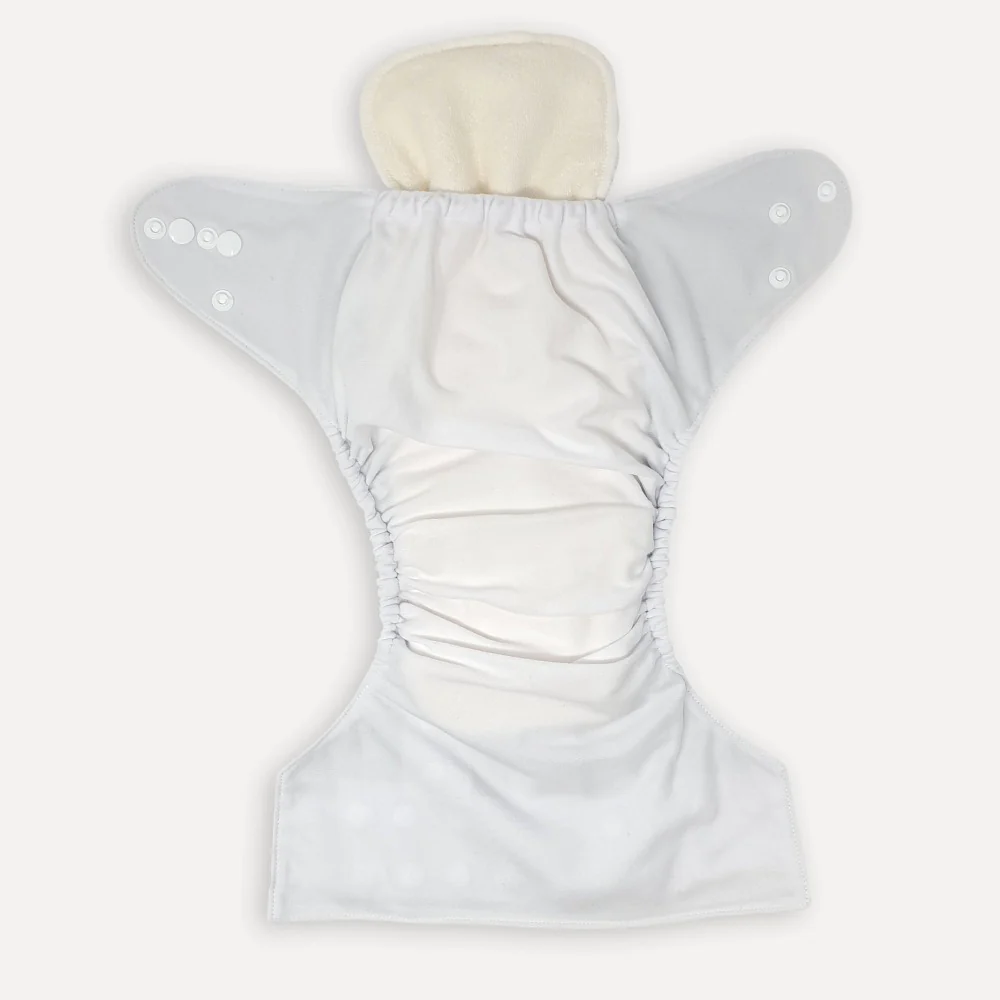
Pad inserts with pocket diaper example from Nora’s Nursery
It’s the most common and easiest one to use. It works well with pocket diapers. Usually the pad is made with bamboo or cotton for maximum absorbency. Even for pocket diapers, I lay the insert directly on top of the lining since it has a better quality fabric than the lining. I want my baby’s butt to touch the best fabric!
Flats

Petite Crown’s cotton and bamboo flats
Flat inserts are what traditional cloth diaper used to be. A big sheet folded into the shape of a diapers used use the cloth pin to secure. It’s still the same idea but you can put the diaper cover over it. It is definitely intimidating but it’s actually the easiest and my favorite way.
I like to fold the flats in the shape of the pre-made insert. There are other ways to fold it and it all works the same. I match it with diaper covers (without the lining). I use this at night since it has more absorbency than pre-made inserts. Also this one is the easiest to use on a rainy day or traveling because it dries super quick!
Prefolds
Prefolds are somewhere between pre-made and flats. It’s usually the length of pre-made and twice or double of the width. You can fold it to use it as an insert or use cloth pins to use it like a flat. I like using this at night or when we’re going out.
Fastening
Snaps
This is the most common method in cloth diapers. There are series of snaps that you can adjust the width and length. You can even adjust to fit a newborn! In the beginning you’ll always think that your baby is in between snap sizes but surprisingly it works in all sizes!
Velcro
Some models have Velcro to fasten the waist. There are still snaps to adjust the length. The Velcro is very soft so it wouldn’t hurt baby’s skin. It’s easy and allows more flexibility, but I don’t like how Velcro sticks to others during the laundry.

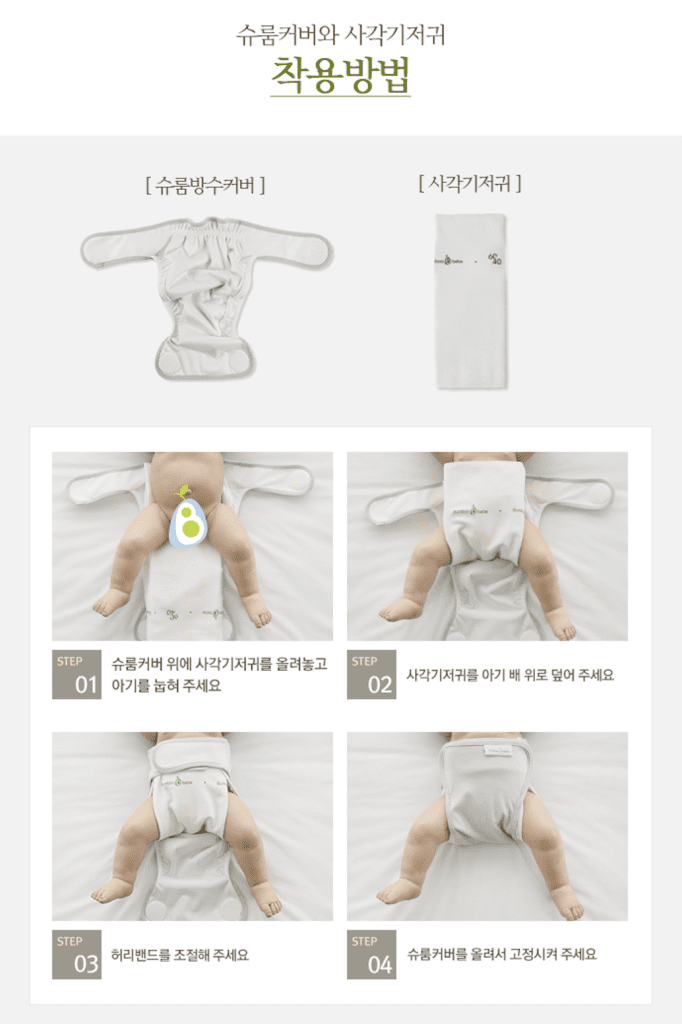
This is an example of Bamboo Bebe’s Velcro style diaper cover. I like using this at night. It’s secure and easy to use with flat inserts.
How to wash cloth diapers
Washing the diapers seem like a lot of hassle, isn’t it? It certainly can be especially in the first month of hectic newborn life. But it easily became one of our laundry routines.
Using all the tips and methods we discussed earlier, now you have a bag full of dirty diapers. Your diaper brands would tell you how to wash it. But in general there are three parts. First wash them using cold quick cycle without soap. It doesn’t have to spin too much. Then wash them in a regular cycle with warm water (make sure water is not too hot) with soap. If your washing machine allows, put extra rinse cycle to make sure all the soap washes away. If your machine only has a set wash program, you can run an extra rinse cycle after it’s done.
It’s best not to use the dryer especially for diaper covers. It might damage the effectiveness of waterproof. I like to run just a few minutes to get rid of lints and hang dry.
I suggest to wash the diapers at least every two days. See how many diapers you have left. I wash them when I have about 5-7 clean diapers.
Can you wear cloth diaper for swimming?
There are swim diapers of course. It’s usually a pocket diaper style with a quick dry material as a liner. Use it without any insert, so it only catches any solids.
My favorite cloth diaper brands
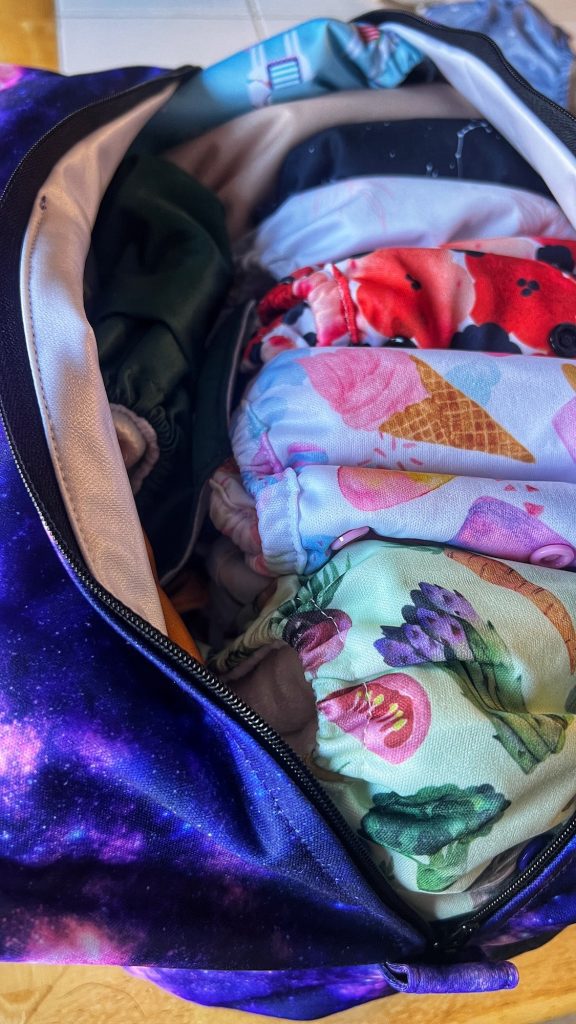

Pocket diapers
Nora’s Nursery has a really nice quality covers. I also like their pad style bamboo inserts. But the lining started creating a lot of lint so I use the insert directly on top of the liner instead of using the pocket.
LPO Baby Boutique (used to be Le Petite Ourse) has unique prints and I like their pocket diaper lining the best. It’s the only one that remains lint-free. But they have the pocket with openings on both end, so the flap on the belly size often comes out.
Diaper covers
Bamboo Bebe is a leading baby brand in Korea who have been pioneering cloth diapers for 16 years. I love their cover with a long Velcro band fastener. I use it at night to secure the thick diaper insert. Also the outside is nice cotton/bamboo which is more breathable than other diaper covers.
Petite Crown has the cutest design and it’s Asian mom owned! I have several of their diaper covers which I love. They have different styles and sizes.
Inserts
I like Nora’s Nursery for their pad style bamboo insert. Petite Crown’s organic cotton + bamboo flats are my favorite. I use it every day. Bamboo Bebe’s flats are probably the softest in the market. It’s not the easiest to fold because it’s so soft! But this flat lining can be used as a light blanket for your baby when it’s not being used as a diaper liner.
All-in-one
LPO Baby Boutique has a convenient all-in-one I use all the time. It has an extra lining that’s attached with snaps and it also has a pocket for an extra insert.
I just got Bamboo Bebe’s newest diaper, all-in-one! Hands down, the insert here is the softest of anything else I have. I’ve washed it many times so far and no visible lint problems! The pocket in the backside of the insert makes it easier to add a layer.
There you have it, the ins and outs of cloth diapers. Once you get in the habit of it, it will become part of your daily routine. What’s your
